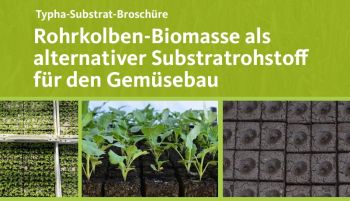TyphaSubstrat
Harvesting and use of cattail biomass as an alternative substrate raw material in growing media for vegetable production.
Background
Germany produces around 8.4 million m3 of soil and substrates per year and is the market leader in the EU with almost 25% (Schmilewski 2017). The Federal Government's Climate Protection Plan 2050 sees considerable potential in reducing the use of peat in horticulture in order to avoid greenhouse gas emissions (BMU 2016). Although there have been efforts to increase the use of alternative substrate raw materials for reasons of moor protection for decades (Gruda 2012), they have so far only accounted for a small share of 25% in Europe and 19% in Germany (Schmilewski 2017). The proportion in so-called “potting soil” for hobbyists is on the one hand higher and on the other hand has grown more strongly than in growing media for professional gardening. In Germany the proportion was 27% in potting soils and 11% in growing media in 2013 (Schmilewski 2017) compared to 7% and 6%, respectively, in 2005 (Schmilewski 2008a). In contrast, the vegetable growing sector uses around 2.5 million m3, more than half of the peat used in professional horticulture.
Particularly in growing substrates, the requirements for the physical, chemical and biological properties of substrate raw materials are very high in order to ensure the economically necessary production reliability in horticulture. However, the available quantities of suitable and established alternatives (e.g. RAL quality-assured compost*, bark humus, wood fibers, coconut products) are relatively small and cannot be increased to a large extent due to competing uses.
In order to replace peat in significant proportions and to be able to completely abandon peat use in the medium term, an expansion of the range of raw materials is necessary. New substrate starting materials must increasingly be sought and tested in a targeted manner. In order to avoid transport emissions and develop income alternatives in Germany, the focus should be on regionally available or producible raw materials.
Cattail (Typha L.) is a native, highly productive marsh plant. Two cattail species are interesting for use: Typha angustifolia (narrow-leaved cattail) and Typha latifolia (broad-leaved cattail). As a climate-friendly management of moorland (paludiculture), its cultivation also offers an alternative to conventional, drainage-based agricultural use of moorland, which is also associated with high greenhouse gas emissions. If cattail biomass is suitable as a substrate raw material, the substrate industry gains a new, renewable raw material that can be produced regionally, which can contribute to the long-term supply of raw materials to the substrate industry. The desired project results are intended to contribute to the transformation towards climate-neutral peatland use and substrate management as well as to ensuring the competitiveness of horticulture and thus strengthen Germany's pioneering role in the production of substrates.
*Quality assured according to the German Institute for Quality Assurance and Labeling
Schmilewski, G. (2017) Growing media constituents used in the EU in 2013. Acta Horticulturae, 1168, 85–92.
BMU (2016) Klimaschutzplan2050. Klimapolitische Grundsätze und Ziele der Bundesregierung. 91 S.
Gruda, N. (2012) Current and future perspective of growing media in Europe. Acta horticulturae, 960, 37–43.
Schmilewski, G. (2008a) Peat overs 77 percent of the growing media production in the EU. IPS Comission II survey. Peatlands International, 1/2008, 39–43.
Aims of the project
The planned project aims to research the sustainable production and potential of cattail biomass as an alternative substrate raw material. Since more than half of the peat used in professional gardening is used in the vegetable growing sector, the project aims to develop a pressed potting soil that has at least 50% peat reduction.
- Determination of the quantity and quality of cattail biomass depending on the production location and harvest time as well as derivation of the nutrient retention potential for the location (bioaccumulation, including herbicide and heavy metal contamination)
- Characterization of cattail biomass as a substrate feedstock: physical, chemical and biological properties
- Development of suitable technology for cattail harvesting
- Development of a suitable processing technology for cattail biomass as a substrate starting material for press potting soils and characterization of the processed cattail biomass
- Development of new, at least 50% peat-reduced substrate mixtures with cattail biomass (and other peat substitutes such as wood fiber, peat moss biomass, etc.) for use as pressed potting soil
- Horticultural practical tests (including young plant growth, durability of the finished young plants, adjustment of culture management during young plant development)
- Knowledge transfer from science to practice
Work packages
WP 1 Coordination, scientific support & public relations (Institute of Botany and Landscape Ecology, University of Greifswald)
The University of Greifswald leads the joint project, coordinates the work and exchange of knowledge and material within the joint venture. Furthermore, the University of Greifswald is responsible for scientific support as well as the targeted knowledge transfer of project results to users. As part of the scientific support, suitable substrate mixtures are also tested in WP 1 in small-scale tests on machine pressability and young plant growth, as well as durability of the finished plants. It is also planned to investigate suitable substrates in large-scale production of vegetables, from young plant cultivation onwards, in an organic nursery. Quality assessments of the individual intermediate products are carried out in collaboration with WP4 to further optimize the substrate mixtures.
WP2 Bioaccumulation (Institute of Pharmacy, University of Greifswald)
The Peat Science and Paleoecology Working Group (University of Greifswald) helps with the selection of locations for field tests on the productivity and quality of cattails. Here, established paludiculture areas as well as natural stands are sampled and analyzed with regard to soil and soil water properties. The Pharmaceutical Biology working group analyzes nutrient, herbicide and pollutant levels that are relevant to the production of a substrate. On this basis, locations and harvest times are defined that fundamentally guarantee the suitability of the cattail biomass as a substrate raw material.
WP3 Technology development (Wellink GmbH)
The technology partner Wellink GmbH will develop and implement a mowing concept for cattails. For this purpose, other external technology companies or technology users of wet technology will be included in the exchange of experiences. The harvesting technology to be developed will focus on chopped material or bundles and will also include the development of a bunker for unloading at the edge of the area. The basis for the development is a chain-based technology for wet locations (Loglogic).
WP4 Substrate development (Forschungsring e.V.)
The Forschungsring e.V. selects potential peat substitutes (including cattail biomass) and tests their suitability as substrate raw materials after processing, in particular by fermenting the raw material. In the case of cattail biomass, this is done in addition to the analysis of the nutrients and pollutants it contains. Furthermore, substrate mixtures are being developed for use as press potting soils for growing young vegetable plants. First, they are manufactured in-house on a small scale and tested for their suitability.
Publications

Oehmke,C., Scheuch, D., Günther, S., König, U.J., Liang, J., Schulze, C., Wellink, R., Venker-Metarp, K. & Couwenberg, J. (2024) TyphaSubstrat - Rohrkolben-Biomasse als alternativer Substratausgangsstoff in Kultursubstraten für den Gemüsebau. Universität Greifswald. 38 S.
König, U. J. (2023) Torfersatz bei Anzuchterden - Einsatz von Rohrkolben und anderen nachwachsenden Rohstoffen. Lebendige Erde 4.
Consortium
- Working group Moor science & Paleoecology, Institute of Botany and Landscape Ecology, University of Greifswald (WP1 Coordination, scientific support & public relations)
- Department of Pharmaceutical Biology, Institute of Pharmacy, University of Greifswald (WP2 Bioaccumulation)
- Wellink GmbH, Stadtlohn (WP3 Technology development)
- Forschungsring e.V., Darmstadt (WP4 Substrate development)











